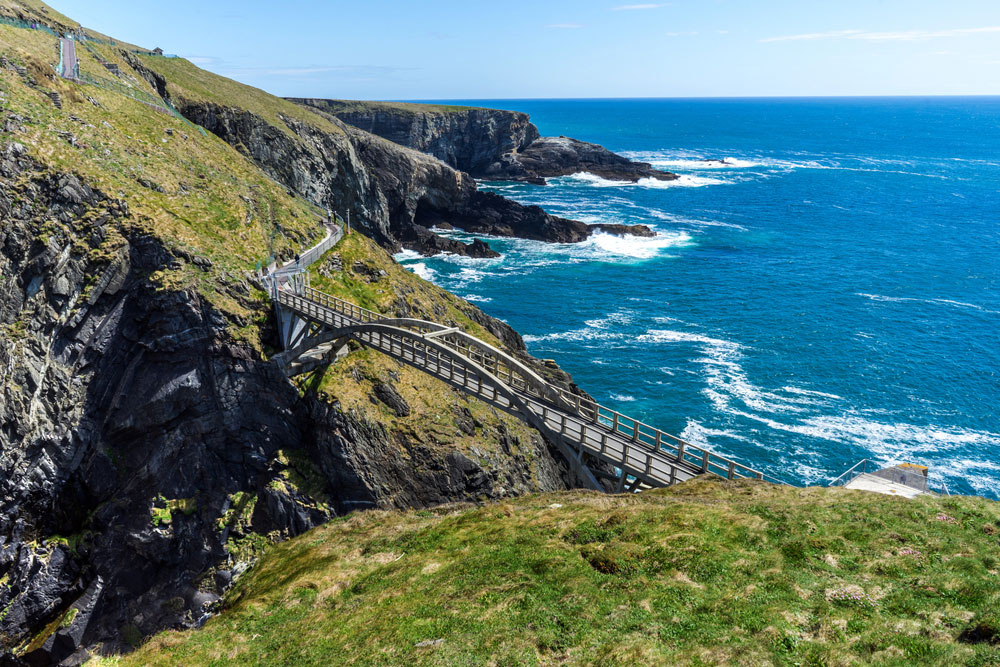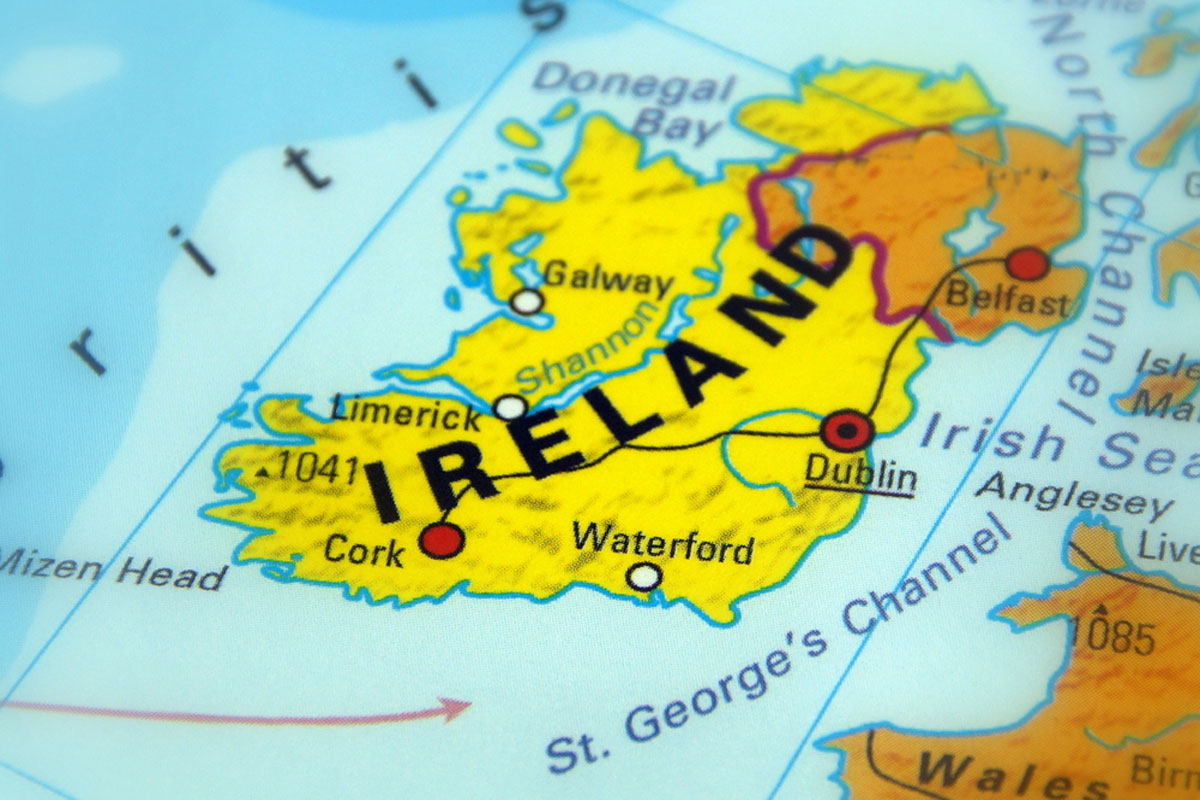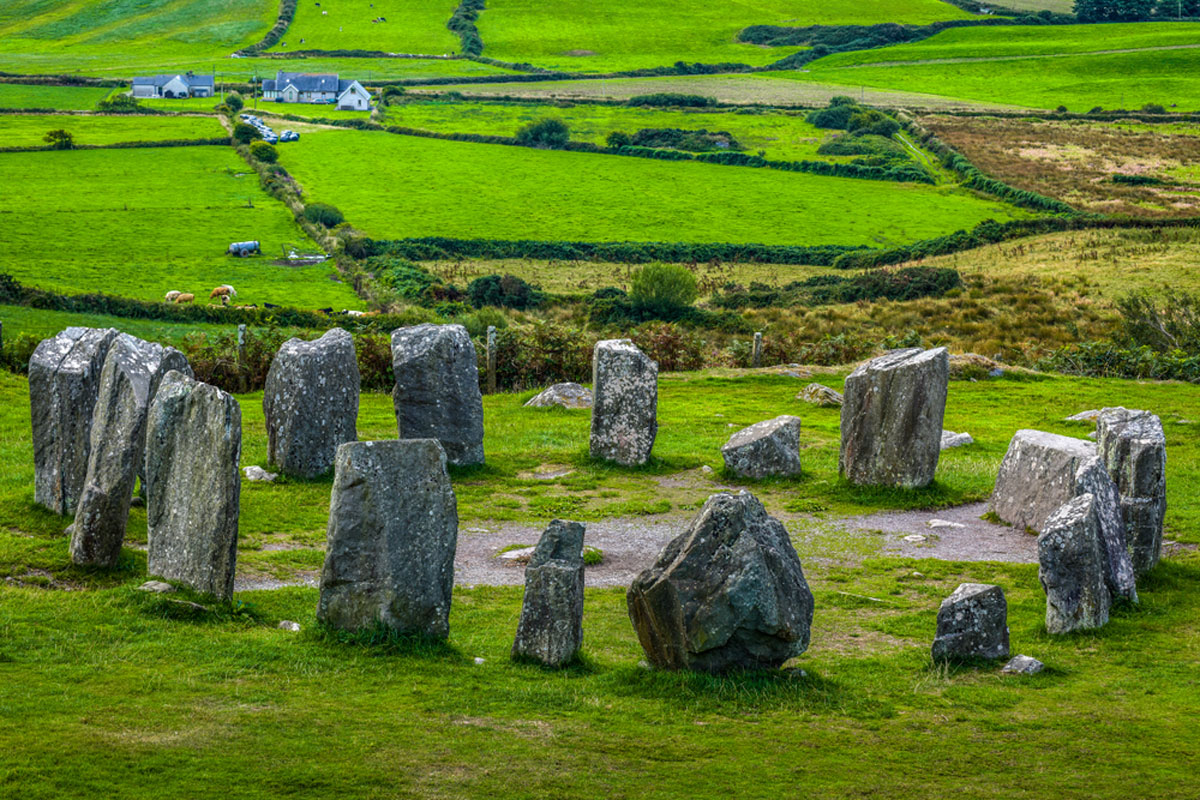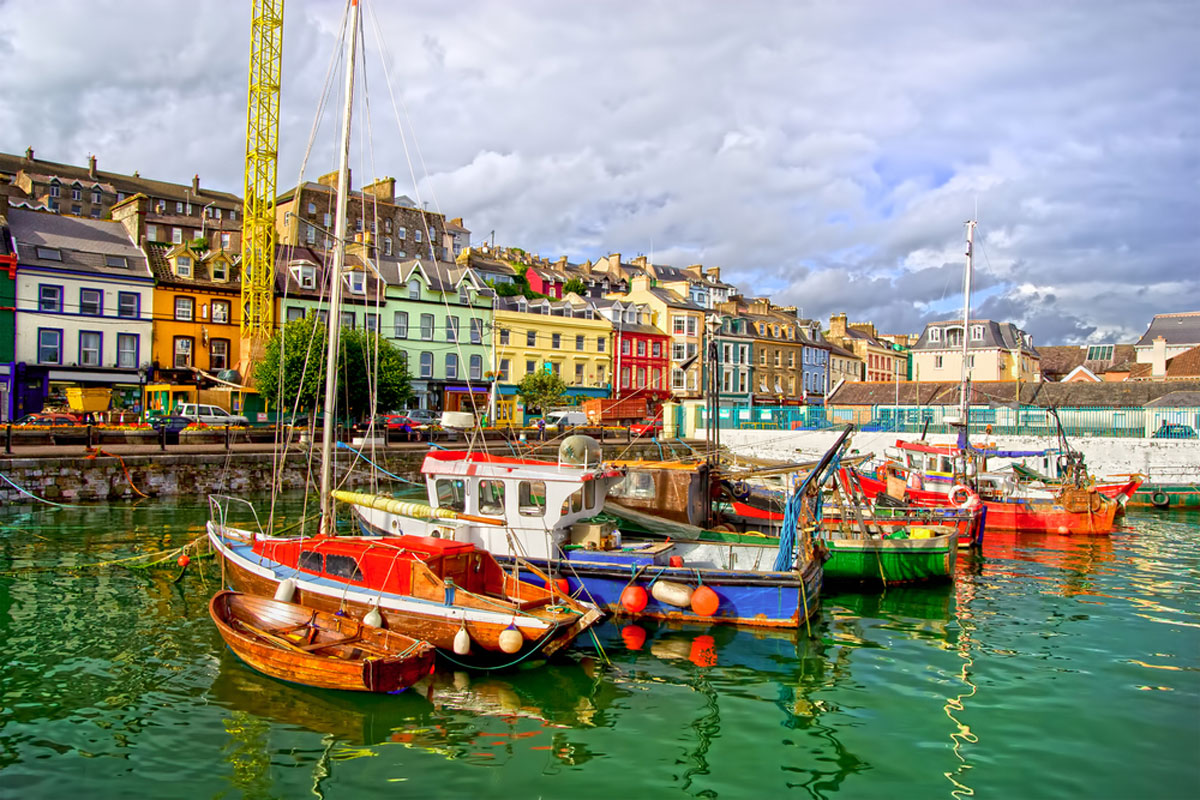Ireland is a place of incredible beauty and deep history, with windswept shores, rolling hills, and old myths. And when one travels through this mystical area, they are drawn to spots that appear to be nature’s masterpiece, like parts of a puzzle that have been entangled with the fantastic and the awe-inspiring.
Mizen Head, Ireland’s most southwesterly point, is one such spot, an untamed and mesmerizing treasure that encourages visitors to embark on a journey into the heart of the country’s raw and rough beauty. It’s a setting that embodies the very soul of Ireland.
A location where the world comes to an end
Perched on the wild, rugged coastline of County Cork, Mizen Head feels like a place where the world ends, and the realms of the unknown begin. As I made my way along winding roads, I couldn’t help but marvel at the dramatic scenery. Lush green hills cascaded into cliffs, and the ever-present Irish Sea’s waves lapped against the shore below. With the sun playing hide and seek in the patchy sky, the landscape seemed to change with each passing cloud.
As I approached Mizen Head, I was greeted by a distinctive bridge that connects the mainland to the rocky island. This slender bridge seemed like a gateway to another world, a world where nature reigns supreme. The Atlantic Ocean stretched out as far as the eye could see, and at that moment, it was as if time had ceased to matter.
The Story of the Bees
Mizen Head has a rich history, particularly that of its distinctive signal station, which was established in 1909. Stepping through its door is like entering a time capsule. The ancient maps and torn logbooks bring to life the stories of lighthouse keepers who once battled the elements to keep mariners safe.
One anecdote that jumped out was the one about the “bees of Mizen Head.” The signal station was infamous for the violent storms that would occasionally cut the employees off from the mainland. A box containing beehives washed ashore during one of these storms in the 1880s. The bees, seemingly unaffected by the upheaval, established a thriving society on the island, producing honey while also serving as an unofficial greeting committee for tourists.
The Signature Bridge
Perhaps the most captivating feature of Mizen Head is the Mizen Bridge. Built in 2011, this dramatic cantilevered bridge has become the symbol of this place. As I walked across it, the world seemed to fall away beneath my feet, and I felt like I was suspended in the heavens. The waves crashing against the cliffs, the wind carrying the salty scent of the sea, and the seagulls dancing on the breeze were all I could hear. It was a sensory experience that’s hard to forget.
This bridge takes you to the Mizen Head Visitor Centre, where you can delve deeper into the history of the place, learn about the lighthouse’s inner workings, and understand the hardships the lighthouse keepers endured. Interactive exhibits, maps, and audio guides help you unravel the tales of this storied spot.
The Lighthouse’s Guiding Light
As you emerge from the Visitor Centre, there it stands – the iconic Mizen Head Lighthouse. Perched majestically at the very tip of the land, it has been guiding sailors home since 1909. As I approached, I couldn’t help but think of all the lives it had saved. The sweeping views from this vantage point are truly breathtaking, and you can easily spot the famous Fastnet Rock Lighthouse, known as “Ireland’s Teardrop” because it was the last part of the country that Irish emigrants would see as they sailed to America.
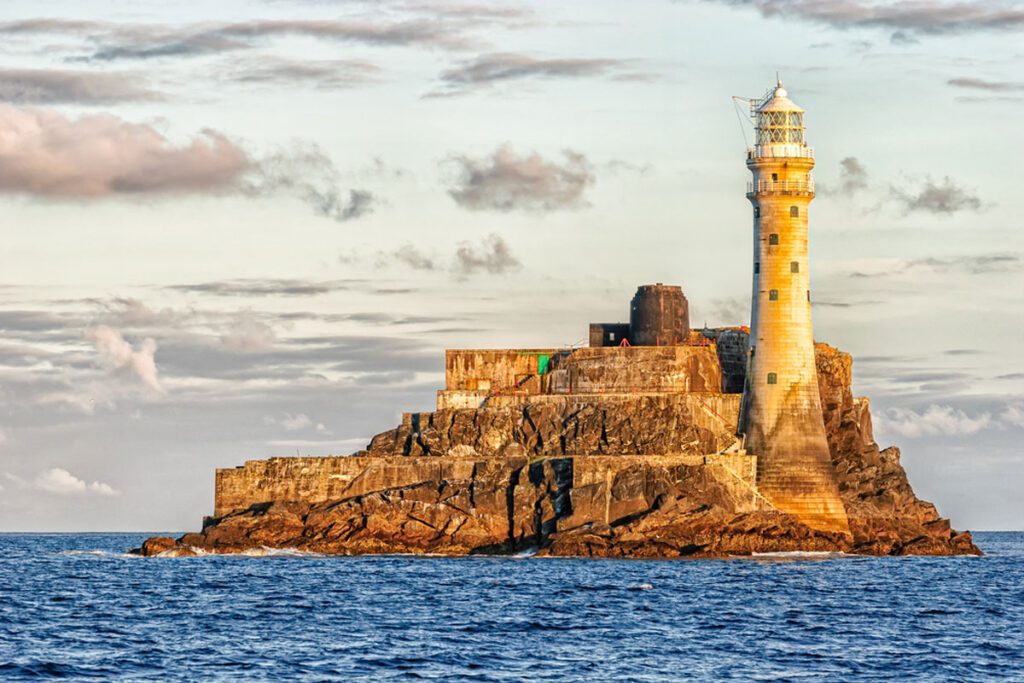
Walking on the Edge
From the lighthouse, a pathway takes you along the cliffs. The wind carries a fine mist from the sea, and as you navigate the stone steps and follow the walkway’s edge, you feel as if you’re standing on the edge of the world. This path offers more than just mesmerizing views; it gives you a profound sense of the relentless power of nature. The elements have sculpted the rock faces into rugged shapes, some of which appear precariously balanced on the edge of the cliffs.
The waves crashing against the rocks are a constant reminder of the Atlantic’s ceaseless motion. The sea’s inky blue is so deep it’s almost black, a color that seems to have inspired countless Irish legends and folktales. I couldn’t help but feel like I was in a place where myths come to life.
A Sanctuary for Wildlife
Mizen Head is a haven not just for the soul, but also for wildlife. Seabirds circle above, their calls filling the air. You might even see dolphins or basking sharks in the waters below if you’re lucky. Nesting birds can be found on the cliffs itself. Fulmars, kittiwakes, guillemots, and razorbills nest in the crevices of the steep rock walls. It’s a spot where the melody of nature surrounds you on all sides.
Whispers of the Past
While Mizen Head is undoubtedly a place of indescribable beauty, it’s also a location marked by stories of the past. As I walked along the cliffs, I couldn’t help but feel the whispers of history echoing in the wind. It’s said that the name “Mizen” comes from the Irish word “Míosán,” which means “middle island.” The word perfectly captures the essence of this place, standing as it does at the crossroads of sea and land.
During World War II, Mizen Head played a vital role in Ireland’s defenses. The island’s bridge was mined to prevent enemy ships from passing, and tunnels were dug through the cliffs to house lookouts. These tunnels are a stark reminder of the war, blending history with the extraordinary natural beauty of the cliffs.
The Signal Tower, built in the 18th century, is another piece of Mizen Head’s history. It was originally constructed as part of a chain of signal towers along the Irish coast. The towers would relay messages using flags or semaphore, acting as an early warning system against a potential invasion. Today, it stands as a silent sentinel, bearing witness to the passage of time.
Sound of the Foghorn
The fog signal station, which holds a gigantic horn, is one of Mizen Head’s most eerily beautiful features. While foghorns have generally been supplanted by contemporary technology, Mizen Head’s horn is still working and blows on rare occasions. The foghorn’s loud, resonating groan serves as a haunting reminder of the lighthouse’s crucial role in guiding ships safely across this craggy headland.
Time Stands Still
Standing at Mizen Head, it’s easy to forget about the stresses of daily life. With its fast-paced demands and computerized screens, the outer world feels a world away. It’s a location where time seems to slow down, or perhaps even stops. The roaring waves and swirling winds remind us that nature has its own rhythm that precedes our human worries.
Mizen Head’s natural, rough beauty is the essence of Ireland. It serves as a reminder that, despite our contemporary world’s amenities, the wild forces of nature still rule in some areas. The cliffs, the lighthouse, the animals, and the rich history all come together to create an unforgettable experience that immerses you in the heart and soul of Ireland.
Mizen Head’s Spell
I had only expected to stay a few hours at Mizen Head, but I became completely enchanted by its allure. I knew I couldn’t leave just yet as the sun began its drop towards the horizon, casting a warm golden tone across the rocks. I found a calm area on the brink of a cliff, perched on a weathered rock. I sat in perfect serenity, the salty sea wind on my face and the rhythmic murmur of the waves below, contemplating this small slice of heaven.
Mizen Head’s influence was tremendous, and as I began my journey back, I couldn’t help but think about how this area was a tribute to nature’s enduring beauty and endurance. It served as a reminder of the need of cherishing and protecting such sites in order to preserve them for future generations.
A Goodbye and a Promise
As I walked back across the bridge to the mainland, the sun had dipped below the sea’s horizon. It was as if Mizen Head had offered me a parting gift, a radiant and fiery farewell. The world beyond was waiting, with its hustle and responsibilities, but I left Mizen Head with a promise to return.
In a world that often moves too fast, places like Mizen Head are like anchors to our past, offering us a glimpse of the Ireland that has been shaped by nature and the passage of time. They remind us to slow down, to appreciate the simple beauty of a sunbeam on the sea, the mournful sound of a foghorn, and the majesty of towering cliffs.
Mizen Head is Ireland’s best-kept secret, a place where the land’s edge meets the boundless sea, and where the spirit of Ireland is etched into the very rock. If you’re lucky enough to stand there, you’ll feel it too, the essence of this extraordinary island, where the beauty of the natural world and the tales of history are intertwined in an unforgettable tapestry.
As I drove away, Mizen Head was but a silhouette in my rearview mirror, but its memory stayed with me. In the quiet of the car, I made a promise to myself to return to this untamed paradise, to feel the wind on my face, hear the waves crash, and walk those cliffs once more. It’s a promise I intend to keep because places like Mizen Head are worth returning to, time and time again.
And thus, with the haunting beauty of Mizen Head still vivid in my mind, I continued my journey, grateful for the secret I had uncovered, for the stories I had heard, and for the spell that this mystical place had cast upon my heart.
Natural Attractions
- Blarney Castle and Gardens – Famous for the Blarney Stone, said to grant the gift of eloquence to those who kiss it.
- Gougane Barra Forest Park – A tranquil park with forest trails, a serene lake, and a historic chapel.
- Mizen Head – Ireland’s most southwesterly point with dramatic cliffs and a signal station.
- Ballycotton Cliff Walk – A scenic coastal trail with stunning views of the Atlantic.
- Garinish Island – A beautiful island with subtropical gardens accessible by ferry from Glengarriff.
Historical and Cultural Sites
- Cobh Heritage Centre – Explore Ireland’s emigration history and the story of the Titanic’s last port of call.
- Jameson Distillery Midleton – Learn about the art of whiskey-making and enjoy a guided tasting.
- Charles Fort – A well-preserved 17th-century star-shaped fort overlooking Kinsale Harbour.
- Blackrock Castle Observatory – A historic castle housing an interactive science and astronomy center.
- Elizabeth Fort – A 17th-century fort offering panoramic views of Cork City.
Lakes and Water Activities
- Lough Hyne – A saltwater lake perfect for kayaking, snorkeling, and stargazing.
- Inchydoney Beach – A pristine beach ideal for swimming, surfing, and relaxing.
- The River Lee – A picturesque river that flows through Cork City, offering opportunities for boating and walking.
- Bantry Bay – Known for sailing, fishing, and exploring nearby islands.
Scenic Drives and Villages
- Kinsale – A charming coastal town known for its gourmet food, colorful streets, and maritime history.
- Baltimore – A picturesque village offering ferry access to the islands of Roaringwater Bay.
- Clonakilty – Renowned for its vibrant music scene, colorful buildings, and Michael Collins Centre.
- Beara Peninsula – A scenic drive with rugged landscapes, colorful villages, and the Healy Pass.
Unique Experiences
- Spike Island – Once a monastery, fortress, and prison, now a fascinating tourist attraction.
- Fota Wildlife Park – A family-friendly park with free-roaming animals and educational exhibits.
- The English Market – A historic covered market in Cork City offering local produce and artisan foods.
- Dursey Island – Accessible via Ireland’s only cable car, known for its walking trails and unspoiled beauty.
- Sheep’s Head Way – A peaceful walking trail with spectacular coastal views and quaint villages.
County Cork is a treasure trove of natural wonders, historical landmarks, and cultural experiences, making it a captivating destination for all visitors.
Helpful Resources




